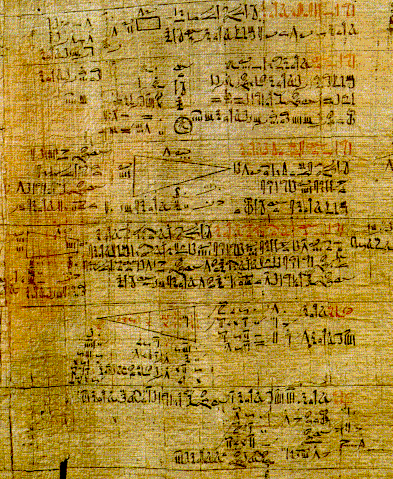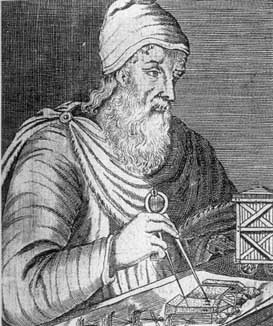The Evolution of Pi
The number pi has surfaced many times throughout
History. It can even be found in the bible:
"And he made a molten asea, ten cubits from
the one brim to the other: it was round all about, and his height was five cubits: and a line of
thirty cubits did compass it round about" (1 Kings 7:23, King James Version).
The Egyptians (c. 2000 B.C.E)
No one really knows for sure when the idea for the ratio of the circumference of a circle
to its diameter first surfaced. The earliest known record referencing this is found on the an
ancient Egyptian mathematical text the Rhind Papyrus. The author of this, a scribe named Ahmes,
wrote, "Cut off 1/9 of a diameter and construct a square upon the remainder; this has the
same area as the circle." In other words, Ahmes method implies that the ratio of circumference
to diameter equals 256/81, or 3.16049... Considering that this is off from the true value of pi
by less than 1%, it was a really good estimate for the time.

Although this approximation could have been better, it was sufficient for what the Egyptians
and Babylonians needed it for: measuring land and building structures. Thus, it was over
a thousand years before the Greeks reexamined this ratio.
The Greeks
The Greeks were somewhat obsessed with exploring ideas. Their first attempted method for calculating
pi was to draw a square of equal area to a circle. This soon evolved into finding the area of
polygons inscribed in a circle to approximate the circles area. The idea was that if they could calculate
the area of a polygon with enough sides, eventually it would be a circle. Although this was a brilliant idea,
the mathematicians of the time did not have the means make such calculations. It wasn't until
Archimedes adapted this idea that they were able to make any real progress (Blatner, 1997).

Archimedes' idea was much simpler, yet almost identical. Rather than considering areas, he would focus
perimeters. His idea was to trap the perimeter of a circle (or the circumference) by first attaining an
over estimate using circumscribed polygons, and then attaining an underestimate using inscribed polygons.
He began finding his overestimate by finding the perimeter of a circumscribed hexagon. Next, he doubled
the sides, finding the perimeter of a 12-gon. He continued this process until he reached a 96-gon, at which
point he must have felt his estimate was sufficient, and he attained the over estimate for pi of 22/7. Next,
he repeated the process with inscribed polygons until, once again, he reached a 96-gon. This gave him the
underestimate for pi of 223/71. Using these two estimates, Archimedes accomplished something that no one
up to that point had; he had found an approximation of pi that was accurate to three decimal places (Stein, 1999).
Want to see what Archimedes did with inscribed and circumscribed polygons? Click
here
The Chinese (1100 B.C.E.)
The Chinese would use this same method to calculate pi. They would repeat the process of inscribed polygons
until they had up to as many as 24,576 sides. This gave them an estimate of pi accurate up to eight deicmal
places. This would be the most accurate value of pi for over 1,000 years.
1600's-1900's
Many mathematicians would calculate more and more digits of pi using Archimedes method. One man, Ludolf Van Ceulen,
would accurately calculate 35 digits of pi using this method. The only difference for him was that this process took
him years and the use of polygons with over 32 billion sides. Little did he know that shortly after his death this method
would become obsolete. Two men, Snell and Huygens, would determine it required much less calculations to inscribe and
circumscribe polygons on a circle simultaneously. Using 96-gons, they were able to verify Ceulen's 35 digits and
eventually surpass this. However, this would be the last method using polygons to approximate pi used, as the groundwork for
calculus was in the makings.
Although infinite series had been posed before, they had been so painstaking that no one really used them. In 1655, however, this
method would become increasingly popular. Several mathematicians (John Wallis, Blaise Pascal, Johann Kepler, Bonaventure Cavalieri,
Pierre Fermat, etc) would help lay the foundations of calculus using these series. Newton himself would create a series that could
calculate pi to four decimal places in just four terms. In the middle of the eighteenth century, it would be Euler who would create
a series using arctangents to calculate pi. This series allowed him to calculate pi to 20 places in under an hour. There wouldn't be
a breakthrough of this significance with regards to pi again until the twentieth century.
Calculators would prove to be the next big breakthough in the calculation of pi. In 1946, a simple desk calculator would allow D.F. Ferguson
to surpass the old record of 707 digits of pi with 808. In 1949, the ENIAC (a really really big computer), would allow George Reitwiesnew, John Von
Neumann, and N.C. Metropolis to calculate pi to 2,037 digits. With this new invention of a computer, the calculation of digits of pi
improved drastically and within five years, mathematicians would calculate pi to over 10,000 digits. Within ten years, they would
calculate it to over 100,000. The algorithms the computers used, however, were still brute force, until in 1976 when Eugene Salamin provided a
quadratically converging algorithm for calculating pi. This meant that the number of correct digits calculated would double with each
step. This algorithm would rocket pi calculations to amazing heights. From this algorithm, others would evolve that would calculate pi
even faster, soon reaching over a billion digits.
Today, calculating pi has become the ultimate stress test for computers. If a computer can calculate pi to the 32 millionth decimal place
without error, it is considered moderately stable in terms of RAM and CPU. Although pi is highly effective in this test, that is not all it
is useful for. Continue your navigation through this site to see some other uses of this incredible number.


